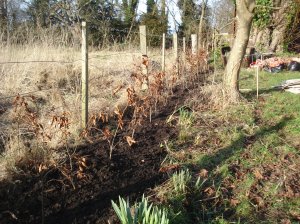At the end of February 2011 we planted copper beech and blackthorn bare root plants (also known as bare root whips) to form a hedge along the boundary between our garden and the neighbouring field. We were told to plant them 18 inches apart (which was far too far apart), heel them in and mulch them with some compost. I recall spending a very unpleasant, back breaking day in driving sleet trying to get the last roots planted as they we already several weeks past when they should have been in the ground.
That first summer there were a few buds and leaves on some of the plants but last year, nothing. What a waste of time and waste of money – they cost 90 pence per plant. The problem seemed to be that the plants never stood a chance against the grass and weeds creeping through from the field. They were strangled and just could not compete.
Last year we acquired some replacement roots and planted them in beside the fruit bushes to give them a chance to establish themselves and today we dug them up and moved them to their permanent spot.
 Learning from our previous mistakes we cleared the area of grass and weeds.
Learning from our previous mistakes we cleared the area of grass and weeds.
 We then dug a hole for each plant approximately 35cm apart and heeled them in.
We then dug a hole for each plant approximately 35cm apart and heeled them in.
 Then we mulched them with compost and gave them a good water…
Then we mulched them with compost and gave them a good water…
 cut out lots of carpet squares to form collars to suppress the weeds…
cut out lots of carpet squares to form collars to suppress the weeds…
 and then covered them with gravel.
and then covered them with gravel.
 Hopefully the compost will help the roots settle in to their new home and the carpet collars will stop any weeds growing around the roots giving them a chance to establish themselves. We thought we had some old carpet but all we could find was the remnants of our new hall carpet and at £58 a square metre we could not bring ourselves to use it. Luckily our neighbours had the end of a roll of carpet which they were more than happy to let us have. It is quite effective and I might use this for some of the vegetables in the summer – it might deter slugs (one can dream!).
Hopefully the compost will help the roots settle in to their new home and the carpet collars will stop any weeds growing around the roots giving them a chance to establish themselves. We thought we had some old carpet but all we could find was the remnants of our new hall carpet and at £58 a square metre we could not bring ourselves to use it. Luckily our neighbours had the end of a roll of carpet which they were more than happy to let us have. It is quite effective and I might use this for some of the vegetables in the summer – it might deter slugs (one can dream!).
Originally we alternated copper beech and blackthorn to get a good mix of copper and green leaves with the added benefit of sloe berries for making sloe gin! The new roots are actually purple beech and although they look copper at the moment, they have the most beautiful deep purple leaves which change to copper in the winter. Apparently it can grow to 18 metres tall….yikes!
 Finally, I have to thank Mr Mac for all his hard work. He did all the digging and planting while I sat in the sun cutting carpet squares. However, Mr Mac was well rewarded for his hard work……..
Finally, I have to thank Mr Mac for all his hard work. He did all the digging and planting while I sat in the sun cutting carpet squares. However, Mr Mac was well rewarded for his hard work……..



